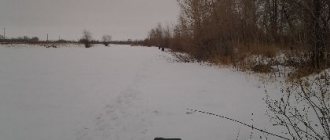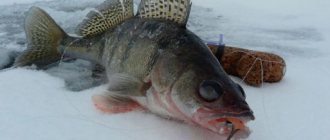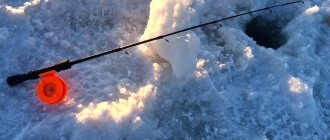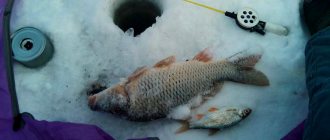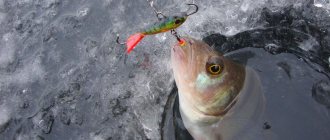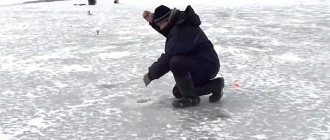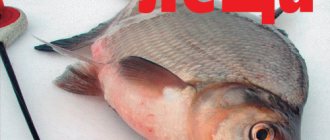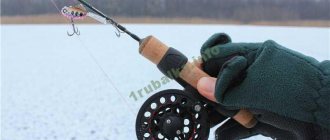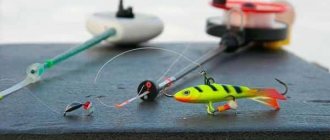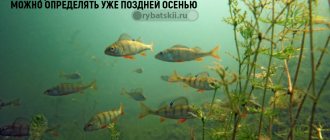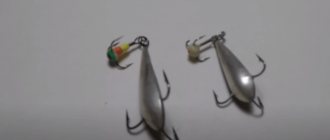Perch can be caught throughout the year, but it is winter perch fishing that is considered the most exciting and exciting, especially on the first and last ice. During these periods, perch is especially active, and its principle of staying in schools makes the fish one of the main objects of hunting. In this article we will thoroughly understand how to catch perch in winter using all available gear.
How to catch perch in winter
The effectiveness of winter fishing for perch is largely determined by the following tactics:
- Study the bottom topography properly and all its features. Early in the morning and in the evening, the perch occupies the edges; at high pressure, it moves closer to the surface
- Holes are made not 1-2, but a much larger number, at a distance of 5-8 meters from each other.
- You need to throw bait into each hole
- They start fishing from the hole that was fed first, after which they move on to the rest
- If you can't catch a perch, try moving from the shore closer to the middle, exploring all layers of water
Winter perch - bait
Catching perch in winter involves using feed bloodworms and winter bait mixtures. They should not be as flavored as summer ones. In cold water, fish react negatively to strong odors. Therefore, in winter it is necessary to use soft-smelling bait.
At this time, the fish are frightened by the contrasting colors of the bait. Therefore, if the reservoir has a dark muddy or clayey bottom, light bait will work worse. The optimal bait mixture should be fine-grained, black or gray in color. Therefore, it is better to sprinkle the bait mixture mixed with water and combine it with food bloodworms.
Perch is sluggish in winter, its metabolism is slow. He eats up much faster than during summer fishing. So the main thing here is to be careful, not to overdo it with the amount of winter bait and bait when fishing.
Fishing for perch in winter is more successful with bait of animal origin:
- live bait;
- dragonfly larvae;
- cow udder;
- bloodworm;
- maggot;
- red worm;
- pieces of liver or fish;
- caddisfly
Bait for fishing with sesame seeds
The bait is prepared simply, there are no expensive components, it is mixed directly while fishing. It consists of breadcrumbs, rolled oats crushed with a coffee grinder, oat bran, roasted peanuts and roasted sesame seeds.
Crackers are the main component of almost all baits. They are usually added 2-3 times more than other components. Bran is sold in stores and is often used in bait. Roasted peanuts must be minced or crushed in a blender. It has a more pronounced smell. And another interesting addition is roasted sesame seeds, crushed in a coffee grinder. There is no need to grind it into dust so that there are small and large fractions. Subsequently, the scales of sesame seeds will be lighter than water and when the bait is washed away by water, they will float to the top and thereby attract fish. An interesting flavor, an additive that is not so popular, but no less effective.
It is prepared like regular dry bait and mixed in the river. If the depth is shallow and there is no current, the water is calm, you just need to make a ball and throw it into the hole. If the reservoir is deep, then when fishing it is advisable to use a regular winter feeder, filling it with bait.
Groundbait with cookies and seeds
Winter bait consists of breadcrumbs, ground rolled oats, jubilee cookies ground in a blender, oatmeal cookies, fried ground seeds, and semolina. There are no exact proportions of the components. The only thing is that in almost any bait, breadcrumbs are the basis. Therefore, their quantity prevails over other components. The best flavoring agent for winter fishing is roasted ground seeds. You also need to add a little semolina, 2-3 times less in volume than crackers. The bait is ready, now all that remains is to mix it with water on the pond.
Fishing places
Most often, perch fishing in winter takes place at shallow depths - up to 2-3 meters. It is best to look for a predator in the following areas:
- Sandbanks
- Channel and bank edges
- Boundaries of remnant aquatic vegetation and clean water
- Bottom irregularities
- Near trees and stones submerged in water
Depending on the type of reservoir, the perch’s parking spots may vary.
Small rivers and lakes
Here it is much easier to look for perch; the fisherman should focus primarily on the coastline, look for steep banks, landslides and slopes. Moving along the coastline, they examine all promising areas - uneven areas, snags, edges, deep-water areas under bush branches.
Large bodies of water
It is more difficult to find perch here due to the larger water area. But you can count on catching trophy specimens. There is no point in moving around the entire body of water in search of fish; it is better to immediately identify possible places for its parking. These can be underwater ridges, dumps, areas near pits.
Lures for winter fishing for perch
These predators prefer various baits. They bite well on red worms and bloodworms. Crumb or bread crumbs can serve as an alternative bait. They are even simply scattered in the water to further attract striped predators.
Perch also eats its own kind, so pieces of its own relatives will also be an attractive lunch for it. You can attach an eye, a perch fin, or something else to the hook. The use of maggots will not be relevant in winter or summer. It is not entirely clear why perches do not react to it, but sometimes there are exceptions.
Tackle
Gear for catching perch in winter is as follows:
- Thin and flexible fishing rod
- Inertia-free reel, the simplest option is enough
- Mono line, the average size of which, depending on the bait, ranges from 0.08-0.18 mm
- Medium hardness nod made of lavsan or polycarbonate
Features of selecting a balancer
Despite the fact that catching perch in winter with a balance beam and a classic-type spoon is not much different from each other, some differences are still present. If you have never fished using the first method before, be prepared to carefully study the topic of which baits are best for catching fish and how to choose them. Provided that you are going to catch pike, consider the following aspects :
- The optimal length of the balancer should vary from 7 to 10-12 centimeters.
- It is advisable to choose narrow-bodied products equipped with large and durable hooks.
- The body should be colored in a color that is often found in the pike's natural habitat. Therefore, preference should be given to the colors of roach, perch or bleak. Unnatural shades can give good results when catching fish that are fattening or standing at great depths.
When searching for pike perch, it is customary to use the following baits:
- Their body length is 8-12 centimeters.
- Pike perch responds well to narrow-bodied and runaway baits.
- The color should remind him of his favorite food, including small perch, roach or gudgeon. If fishing is carried out at great depths in holes and pools, then baits with an acidic bright yellow or silver color work well there. At shallow depths, darker products perform well.
Well, if we talk about perch fishing, it involves the use of such balancers:
- The optimal length of the bait varies from three to 5-6 centimeters. The best catchability is typical for models 4-5 centimeters long.
- When choosing colors, preference is given to colors that imitate fry of perch or bleak.
- The best shape is narrow-bodied and more rounded.
Fishing methods
Perch is caught in winter using many baits, which explains the variety of methods used to catch it.
Lure fishing
There are a huge number of winter spinners for catching perch, so when choosing, follow these tips:
- The best materials for spinners are copper, tin, brass.
- Color is not so important; perch generally prefers dark-colored baits
- At the beginning of winter, perch go better with small spoons, gradually increasing their size
For winter fishing of perch with a spinner, a regular winter fishing rod, 50 cm long, equipped with a nod, is used. The length of the whip is about 30 cm, several passage rings. Fishing line with a diameter of 0.15-0.18 mm.
Lure fishing involves examining a large number of holes. The standard game with the bait is when it sinks into the hole to the bottom, followed by a short rise and smooth swings.
During periods of increased activity of the perch, the amplitude of the strokes reaches 20-30 cm, at the extreme points there are pauses of several seconds. If there are no bites within 3-5 minutes of such a game, change the hole.
Fishing with a jig
Catching perch in winter with a jig is one of the most popular methods. To do this, use various baits - bloodworms, burdock moth larva, maggot.
Jigs used when fishing with bait must meet the following requirements:
- Drop-shaped or spherical shape
- Size approximately 3-4 mm - for fishing at medium depths and large - for catching trophy perch at great depths
- Bait material – lead, tin, tungsten
- The color may be different; yellow and red jigs are often used, additionally attaching bright beads
- Jig weight - depending on the bait
For fishing with a jig, a light winter fishing rod equipped with a nod is suitable. The flexibility of the nod is selected depending on the jig, under the weight of which it should not bend more than 30 degrees.
The fishing rod is equipped with a thin, transparent fishing line with a diameter of 0.1-0.12 mm. The use of colored fishing lines is unacceptable.
The tactics for fishing with a jig are as follows:
- The bait sinks to the bottom, after which it rises up 15-20 cm and sinks to the bottom again
- The ascent becomes greater, they try to change the speed of ascent and descent
- The jig is lowered and raised with sharp jerks with pauses at short distances from the bottom
- The jig is lowered to the bottom and several taps are made, from which a cloud of turbidity rises from the bottom, attracting fish
The speed of play with the bait, the amplitude - all this needs to be selected, they largely depend on the degree of activity of the perch, the characteristics of the reservoir, and the weather.
Reelless fishing
You can successfully catch perch with a baitless jig. These are baits that, in their shape, resemble various small aquatic inhabitants that serve as usual food for fish. There is no need for a nozzle.
The most suitable reelless baits for perch include the following:
- Uralka
- Ant
- Banana
- Butterfly
- Nymph
Sizes and colors are selected as fishing progresses, but it is worth noting that silver and dark baits are often more catchy.
The fishing rod for baitless fishing is used almost the same, only the nod is set to a longer length - up to 10-15 cm. Thin, transparent fishing line, with a diameter of about 0.1 mm.
Fishing tactics are practically the same as with a regular jig - standard ascents and descents, with or without jerks.
Fishing with a reel requires more concentration and constant movement of the bait. Therefore, it is better for beginners to start practicing with a regular jig.
Catching a devil
The Chertik is essentially also a baitless jig, with the difference that it has a triple hook. For perch, a devil about 20 mm long, elongated, teardrop-shaped, is suitable.
The fishing rod used is the same, but with a medium-hard nod. The fishing line is thicker - 0.1-0.14 mm, since this bait involves catching large perch.
Fishing tactics involve descents and sharp ascents, after which the bait is allowed to smoothly sink to the bottom. After a short pause, everything repeats. You can tap the bait on the bottom, raising the mud, and move it slightly, imitating the movements of an insect.
The devil is a universal bait used in different bodies of water and in any weather.
Fishing on a balance beam
A balancer is a bait that looks like a fry in its appearance. It is caught more often in the middle layers, it is located horizontally. In its play, the balancer resembles a small fish. Equipped with two hooks.
The balancer for perch is selected according to the following parameters:
- Length 4-5 cm, allows you to catch both small and trophy perch
- There are no special restrictions on shape, although there is an opinion that wide-shaped baits work better.
- The color is preferably natural, characteristic of fish fry, which are the main food for perch
To catch perch in winter on a balancer, use a shorter winter fishing rod of medium hardness, equipped with a reel. Mono line, diameter 0.16-0.18 mm.
The fishing tactics using a balance beam are usually like this:
- The balancer sinks to the bottom
- Then it rises slightly, after which a sharp swing is made so that the bait flies up 30-35 cm.
- The rod returns to its previous position
Fishing on the bulldozer
This bait is well suited for winter perch fishing. They make it themselves from an elongated sinker, a pair of crochet hooks, cambrics and beads.
A loop is knitted at the end of the fishing line, to which a sinker with hooks on the sides is attached. The hooks should move freely along the line. Cambriks with beads are put on fishing line and hooks. The weight of the sinker depends on the depth of fishing and the strength of the current.
Take a rigid fishing rod, with wire rings and a reel. Definitely a nod.
The tactics for catching perch on a bulldozer are as follows:
- The beam sinks to the bottom
- There should be a sharp rise of 20-25 cm
- Next is the return descent
- Pause for 5-10 seconds, then everything repeats
The point of using a bulldozer is that it raises turbidity, and the bright beads act as bait.
Balda is a bottom tackle, so it is advisable to use it when the perch stays near the bottom.
Fishing with live bait
To catch perch in winter with live bait, use a winter fishing rod of medium hardness, with a fishing line with a diameter of 0.14-0.18 mm. Hooks should be as thin as possible, with a long shank, so that the baitfish remains active for a long time.
The following are used as live bait:
- Bleak
- Verkhovka
- Minnow
- Bystryanka
This kind of fishing has some of its own characteristics:
- You should fish in places where small things may accumulate - near the remains of coastal vegetation, algae
- Monitor the condition of the live bait as often as possible and replace it if necessary.
- The rig involves the use of several weights, the smallest of which should be located near the hook
Subtleties of finding a place
If we talk about catching perch on a balance beam in winter, then it is conventionally divided into several periods - first ice, deep winter, last ice :
- In the first period, the balancer demonstrates incredible performance, especially if the angler chooses a promising fishing spot and follows the technique. The striped hunter and the toothy predator prefer to stay in heavily overgrown areas, rubble with flooded trees, bushes and all kinds of bottom anomalies.
- The most trophy specimens are often found at the upper edges, where there are dumps of deep holes. As for pike perch, in the first days of winter it is found in deeper areas, including dump sites and places with steep banks of rivers and reservoirs.
- The second period forces predatory fish to move to deeper areas where warm water is present. There, the inhabitants of the depths can stay until the arrival of spring. The chances of catching several decent specimens increase when fishing on rivers with medium and fast currents.
- At the end of winter, predatory fish begin to pursue schools of fry, which move en masse to areas with access to rich food and oxygen penetrating underwater from the shore. As a rule, these are shallow areas in the coastal zone with a current present. There, perch and pike are caught until the reservoir is completely free of ice. The behavior of the pike perch is a little noticeable, because it still stays in holes and dumps in them, trying to arrange a shelter in snags and cluttered pools with a hard bottom.
Perch fishing in December
Perch fishing this month is particularly stable. This is a period when the first ice is just appearing on some reservoirs, which in itself implies high fish activity. On other bodies of water, the ice has been holding for a long time, the heat has passed, but there is still every chance of a good catch.
There is an opinion among anglers that after the period of first ice, the perch bite declines, but this is not the case. The fish simply take their usual wintering places, where they also continue to feed.
Therefore, for the most part, attention should be paid not to searching throughout the entire reservoir, but to targeted fishing of promising places.
Fishing for perch in winter
Lures that allow you to hook the most passive perch at a time when he does not react to anything at all. Sometimes they give results in the most hopeless ice fishing situations. This is all the gear that hits the bottom:
- eggs;
- bombs;
- turtles.
The technique of these baits is to tap the bottom with a large weight, move it, and raise the mud. Strange, but the sluggish, passive winter perch changes its behavior after this. Therefore, this method takes pride of place. And in the middle of nowhere, if the perch doesn’t want to react to anything at all, you need to try this tactic. Perhaps she will make fishing successful.
Catching perch in winter on a bulldozer involves hanging in one place with a fishing rod for quite a long time. The fish must be forced and tortured so that it takes the bait.
Spinner fishing technique and balancer
The technique of vertical trolling from ice is quite simple. The bait sinks to the bottom, and sharp short strokes are made with the rod. After each toss of the spoon there is a pause. For gliding spinners and balancers it is 3-5 s, and for “nails” a stop of 1-3 s is sufficient. The bait is played with a wrist movement of the hand, the amplitude of movement is in the range of 20-40 cm.
Often when biting from the bottom, it is useful to place the spoon directly on the ground during a pause. At this point, you can move the bait a little to entice the perch to bite.
When using a balancer, the game runs smoother. The pause time is selected depending on the model. To determine the duration of operation of the balancer, just look into the hole. After swinging the rod, you need to note the time it takes until the bait completely stops under the hole.
Perch do not always hunt near the bottom. Therefore, by reeling the fishing line onto a reel, you can find the horizon where the fish are hunting. Sometimes the striped predator rises to the hole itself, so you need to check the entire vertical, starting from the bottom and ending with the layer of water directly under the ice.
Despite the apparent simplicity of vertical trolling for perch, not every angler manages to master this method of fishing. Some people didn’t put enough effort into assembling the fishing rod, while others were too lazy to drill numerous holes. As a result, only the most scrupulous and persistent fishermen will have a catch.
